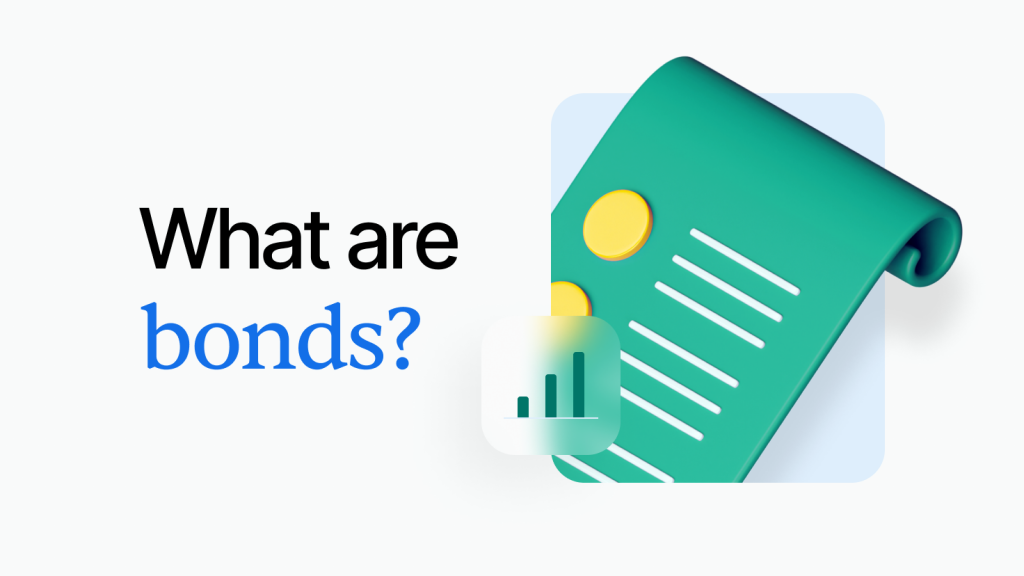Dive into the world of bonds with our comprehensive guide. Understand what bonds are, their types, benefits, and how they compare to other investment options. Perfect for beginners seeking stable investment avenues in 2025.
A bond is a debt security, or simply put, a form of “I owe you” (IOU) between a lender and a borrower. Bonds are commonly issued by a government, a government agency, or a company to finance projects or other needs.
In return for lending money to the bond issuer, the issuer promises to pay you a specified interest rate during the life of the bond, and the principal of the bond when it matures. Because bonds have a fixed interest rate, they’re referred to as a type of fixed-income instrument.
How do bonds work?
When you invest in a bond, you’re lending money to the issuer in exchange for periodic interest payments (known as coupon payments) and the return of the principal amount, also called the face value or par value, when the bond matures. To understand this whole process, let’s walk through how bonds work.
First, the issuer decides to raise funds by issuing bonds. The issuer determines the face value, coupon rate, maturity date, and other terms of the bond.
After issuance, bonds can be bought and sold on the secondary market. The market price of a bond may fluctuate based on a few factors including changes in interest rates, credit risk, and overall market conditions.
Lastly, each bond has a maturity date, which is the date on which the issuer agrees to repay the bond’s face value to the bondholder. At maturity, the issuer “redeems” the bond by paying back the principal amount to the bondholder. This completes the bond’s life cycle.
When you buy a bond, you can hold it and collect the interest payments until it reaches maturity. In this case, you won’t be affected by fluctuations in the bond’s value – your interest payments and face value will stay the same.
The pros and cons of investing in bonds
There are several benefits and drawbacks when it comes to investing in bonds. Each of these should be considered based on your investment goals, risk tolerance, and overall financial strategy.
Pros:
- Regular and predictable income
- Hold the bond to maturity and get all your principal back
- Can help diversify an investment portfolio
- Considered lower risk investment compared to other assets
Cons:
- Bonds typically pay out lower returns than other assets, like stocks
- There’s a risk that the issuer might default on interest payments or fail to repay the principal amount at maturity
- As interest rates rise, the yield on newly issued bonds increases, leading to a decrease in the demand for existing bonds and causing their prices to drop
Many ask, “Why invest in bonds?” Bonds are a great way to help diversify your portfolio. They offer less volatility than stocks and predictable cash flow. Fixed-income assets, like bonds, can satisfy an investor’s need for income even when interest rates are low, despite the fact that they come with some risks, as do most investments.
Types of bonds
There are various types of bonds, each with its own risk-return profile. Because of the varying types, investors can choose bonds based on their investment objectives, risk tolerance, and market outlook.
| Government bonds | Issued by governments, they typically offer fixed-interest payments and are considered benchmark securities. Examples of government bonds are U.S. treasury bonds or German federal bonds. |
| Corporate bonds | Issued by corporations, these bonds can be divided into 2 types in terms of risk and yield. Investment-grade credit ratings are believed to have lower risk. In contrast, high yield bonds (also known as junk bonds) generally offer a higher yield and are issued by companies with a higher risk of defaulting or missing interest payments. |
| Municipal bonds | Issued by local governments, these bonds are often used to fund public projects like schools and infrastructure. |
How to buy bonds
Bonds are known to be difficult to access for investors because they normally require investments in the 5-digit range or higher. Moreover, many bonds, especially high-yield ones, aren’t available to retail investors at all. We want to provide an opportunity for all investors to benefit from investing in bonds: On Mintos, you can invest in bonds, starting from as little as €50.
Key terms to know
Coupon rate: The annualized interest rate paid to investors. Also called nominal yield.
Maturity: The date when the principal (also known as face value or par value) of the bond is to be paid back to investors and the bond ends.
Security: A bond can be secured or unsecured. A secured bond pledges specific assets, also called collateral, to bondholders if the issuer can’t repay its obligations. Collateral is an item of value, normally money, that a lender can seize from a borrower if they fail to repay a loan according to the agreed terms. Unsecured bonds are not backed by collateral.
Liquidation preference: When a company is liquidated, its creditors are repaid in a particular order. Senior debt must be repaid first, followed by junior (subordinated) debt. Stockholders get whatever is left.
Callability: If a bond has a call provision, it may be paid off by the issuer before maturity.
Bond yield: This is the annual income generated by a bond as a percentage of its face value. It’s the interest or coupon payment that a bondholder receives relative to the bond’s current market price.
Yield to Maturity (YTM): The total return anticipated on a bond if it’s held until maturity. It takes into account not only the coupon payments, but also any capital gains or losses resulting from the bond’s price changes over time. YTM is often considered a more comprehensive measure of a bond’s potential return compared to just looking at its coupon yield or current yield.
Bond return: Bond return encompasses the total gain or loss an investor experiences from holding a bond over a specific period.
1 When you invest in Fractional Bonds on Mintos, you buy bond-backed securities. You won’t hold the underlying bond directly.

